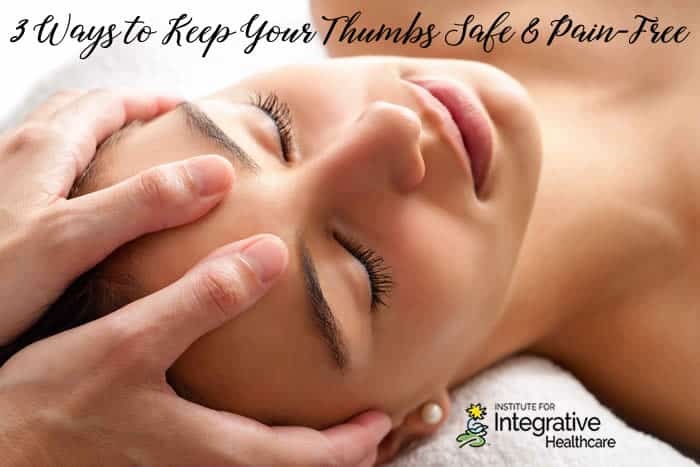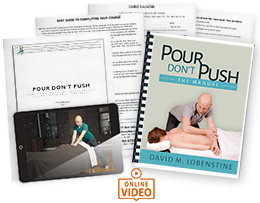

We massage therapists love using our thumbs. What’s not to love?
Our thumbs make it possible for us to do deep, specific work.
Our thumbs make our clients happy.
But as you know, using our thumbs causes problems. Our thumbs are one of the most oft-injured parts of the massage therapist’s body. Nearly every massage therapist I teach has felt soreness in their thumbs; many have experienced pain or injury.
However, we therapists are nothing if not problem solvers. So when our thumbs start to hurt, we experiment.
- One solution is to try and avoid using your thumbs. Some hurting therapists change the kind of therapy they do altogether; they start doing craniosacral or energy work, for example, to reduce the wear and tear on their thumbs.
- Some therapists make other radical adjustments in their approach to massage—learning how to give a session with only with forearms and elbows, for example, to avoid using the thumbs and fingers at all.
Both of these solutions have their advantages. But both solutions also contain a big problem: they force us to give up one of our primary—and most satisfying, and most therapeutic—points of contact. With this drastic solution, a therapist is acknowledging that a crucial part of their body is broken, and that they have to spend the rest of our careers avoiding that broken part of our body.
I don’t think that’s healthy for our bodies, or for our minds.
Then there is the opposite, equally problematic, option. As much as we are problem solvers, we therapists are also just really, really stubborn. Many of us feel soreness and pain but we just keep on going, keep on using those thumbs, keep on pushing through. We ignore the problem. We believe we just need to make it through this session; make it through this day; make it through this week…
Believing that things will get better on their own is tempting, but not a long-term solution.
What if there was a way to continue to use the modalities that we most love, while also taking care of our bodies? Instead of giving up on your thumbs, I want to show you how to use them more effectively.
The solution is not all or nothing. The solution shouldn’t be: continue to use them and be in pain. Or stop using them altogether.
Instead, the solution should be to use them in a way that is both smart and satisfying. A way that keeps both our clients’ bodies and our own bodies happy.
View full description of Using Your Thumbs Wisely
The 3-Step Solution
The solution has three parts. To keep your thumbs safe, you need to:
- Use your thumbs less.
- Use your whole body more.
- Support your thumbs and keep them in line.
Let’s explore these one at a time.
1. Use Your Thumbs Less
Your body offers you an astounding amount of tools. Beyond the thumb, think of all the points of contact you can use for your massage strokes:
- heel of hand
- soft fist
- knuckles
- fingertips
- forearm
- elbow
There are few other things that we do in our days that we can successfully accomplish with seven different parts of our body! So, first and foremost, acknowledge the enormous tools you do have. The thumb is an easy tool for us to rely on—it has more nerve endings than any of the above, and thus we can sense with astonishing detail what is happening under our thumbs. But I believe that you can cultivate those other parts of the body to be perceptive too. It just takes practice.
In your next session, start to notice all the times you begin to use your thumbs without even thinking about. Then…let yourself think about it! Do you need to use your thumbs? Or is there another part that could accomplish that stroke just as well?
Each time you choose to use another point of contact means you are relying less on your thumbs. Each of those moments reduces the strain on your thumbs, and allows you to save the thumbs for when they are truly essential. But just as importantly, choosing your point of contact for each stroke more intentionally will ultimately make you a more dynamic therapist, less likely to get caught in a rut, more likely to continue to grow and challenge yourself. And isn’t that what we all want for our careers?
2. Use Your Whole Body More
What I’ve noticed from teaching for more than a decade is that we therapists tend to put our thumbs on a pedestal. We think our thumbs are special—that they are what allow us to work as deep as the client wants us to do. But that is false—our thumbs aren’t actually creating that pressure—chances are, it is the muscles of your arms and shoulders and back that are enabling you to work as deep as you think you are supposed to.
We need to learn that we don’t need our thumbs to do deep work. And, in fact, we don’t need our arms and shoulders, either. Or, at least, not in the way we think we do.
As I demonstrate in Pour Don’t Push, and my other CE courses, the most effective way to do whatever kind of massage you want—from the lightest of healing touch to the deepest of myofascial release—is by creating every stroke, every contact, with your whole body.
We typically use the muscles of our arms and shoulders and back to push down into the client. But there is another option: using your body weight, which is more powerful and enduring than muscular contraction, in order to pour into each stroke. Think of your lower body as the creator of the stroke, and the upper body merely as the conduit of the lower body’s efforts.
What happens if you envision your next effleurage stroke as starting way down at your feet? Imagine creating that stroke by moving from your hips, and letting your hands just go along for the ride, rather than actually make the stroke themselves.
As you start to feel this possibility for a full-body stroke, not only will you be able to work more deeply, but you will also get more comfortable with using all of your points of contact. Creating each stroke from our whole body means that we can feel the power that we have—no matter which point of contact we use—and thus we can let go of the idea that we “need” our thumbs to do deep work.
3. Support Your Thumbs and Keep Them in Line
Let’s be honest: there are times when using the thumbs really is the best choice. I am definitely not suggesting that we stop using our thumbs entirely. Rather, we need to use them less, and we need to use them smart.
And the way we do that is by supporting them and keeping them in line.
I like to think of our thumbs as unruly teenagers. They want to go new places and try new things. Even things that are stupid and dangerous. And also, they always think that they know what is best—they think they know everything.
We need to teach our thumbs that is not true. Just like with that teenager who wants to smoke in the bathroom and cut class, we need to set clear boundaries and expectations. In other words, we have to keep our thumbs in line.
The way that we do that is, literally, keeping them in line.
The next time you use your thumbs as you massage, notice where they are in relation to your hand and arm. Chances are they are at an angle, rather than in a straight line with the whole arm. Because our thumbs are curious and bossy and stubborn, they like to wander away from the rest of the body. Chances are, at some point during a massage, your thumbs look less like an extension of your whole upper body, and more like windshield wipers, sweeping back and forth, wearing out a little bit more with each swipe against the tissue.
Moving the thumbs is a hard habit to break, but worth the effort. The shift is simple: don’t move the thumbs at all. Move the rest of your body instead. Your thumbs should be the end point of a straight line that starts all the way at your shoulder. In almost any stroke, you can keep those joints of the arm stabilized, and then move from another, bigger joint (namely your hips or your knees) further down the kinetic chain. You’ll still be able to do what you need, but with less movement within the smaller, more injury-prone joints, and more movement in those larger, more enduring joints.
Whenever possible, your thumb should be supported—sitting on top of your closed fist. That way you are using less muscular effort in the thumb itself—you are giving the thumb a platform, so that it can be a point of contact more effectively. Just like our unruly teenagers need caring, loving support, even when they are driving us crazy, our thumbs need extra support as well. When we cradle the thumb against our curled fingers, it is less likely to try and do everything all on its own, and more likely to work in harmony with the whole body.
Experiment with how you can implement this three-step solution, starting in your very next massage!













